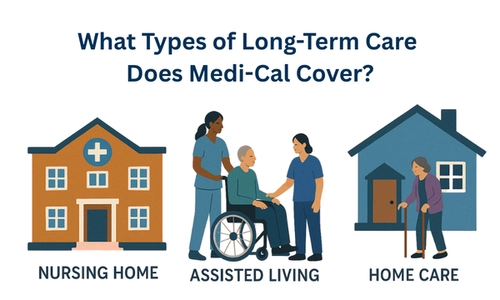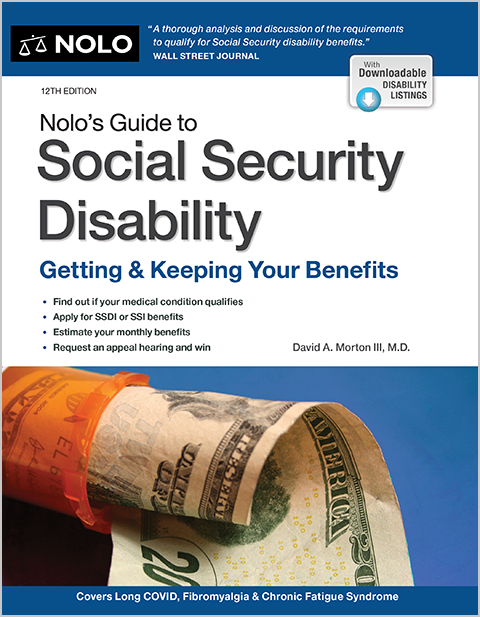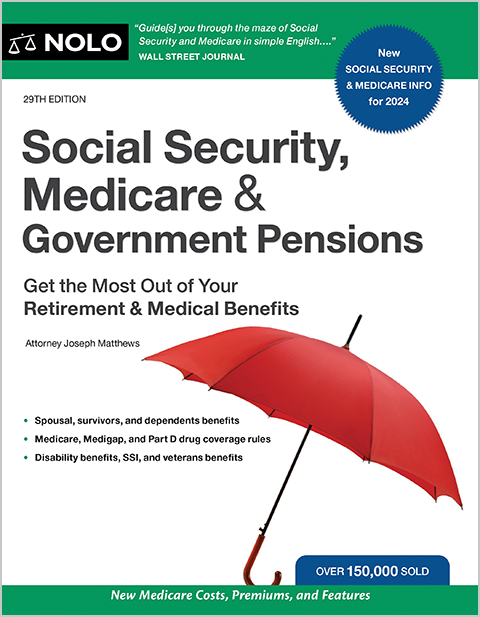In California, Medi-Cal sometimes pays long-term nursing home and home care costs if you can't afford the cost of a nursing home.
Long-term care like nursing homes, assisted living facilities, and home health care is expensive, and private health insurance policies generally don't cover those services. Likewise, Medicare coverage for long-term care is very limited, and few people have purchased private long-term care insurance policies.
For California residents needing long-term care services, Medicaid is the most common source of funding. Medicaid pays for the nursing home expenses of just over 60% of the residents in California nursing homes.


Medi-Cal, the name of California's state Medicaid program, is funded by both federal and state funds, and it provides health insurance to more than one-third of California's population. There are many different ways to become eligible for Medi-Cal, and there are specific eligibility rules for long-term care services like:
- nursing homes
- assisted living facilities, and
- home health care services.
The California Department of Health Care Services (DHCS) administers long-term care programs in California.
Does Medi-Cal Pay for Nursing Homes in California?
Skilled nursing facilities are residential facilities that offer round-the-clock skilled nursing care in addition to other supportive services. These nursing homes are expensive, with private room costs averaging approximately $13,200 per month in California. Most people can't afford to pay their own nursing home expenses.
Medi-Cal, however, will pay for a nursing home only when it's "medically necessary." California defines medically necessary as "when it's reasonable and necessary to protect life, to prevent significant illness or significant disability, or to alleviate severe pain."
For Medi-Cal to pay for a nursing home stay, your treating physician must prescribe a nursing home for you because you either need the continual, round-the-clock availability of skilled nursing care or what's called "intermediate care."
Skilled nursing care includes things like:
- giving injections
- inserting or replacing catheters
- changing wound dressings
- feeding through a gastric tube, and
- treating bedsores.
Intermediate care means a protective and supportive environment with "observation on an ongoing intermittent basis to abate health deterioration."
To determine whether you need at least an intermediate "level of care" (LOC), Medi-Cal will do an LOC assessment that looks at your limitations in your activities of daily living (ADLs), cognitive function, and physical function, as well as your need for help with medication and treatments. (Cal. Code Regs. tit. 22 § 51124.)
If you need a health care aide or nurse only for one or two things a day, then Medi-Cal might find that a nursing home stay isn't medically necessary, because you could get these services on an outpatient basis or by a home health provider. In essence, your doctor must find that your health is at risk if you don't have access to skilled nursing or intermediate care.
Does Medi-Cal Pay for Home Health Care in California?
California covers home health services as part of its state Medicaid plan. Medi-Cal covers home health services that are medically necessary, like skilled nursing care and medical equipment. For individuals who need ongoing, non-skilled care like help with bathing, cooking, and chores, California has the In-Home Supportive Services (IHSS) program, which is also a part of Medi-Cal.
The IHSS program pays for home care services that aren't necessarily medical in nature. The types of services covered by IHSS include:
- housecleaning
- meal preparation
- laundry
- grocery shopping
- help with bathing
- bowel and bladder care
- accompaniment to medical appointments, and
- protective supervision for the mentally impaired.
To be eligible for IHSS, you must be 65 or older, disabled, or blind, and you must be living in a home, not an institution. In addition, you must meet the financial eligibility criteria for regular Medi-Cal (see below), and you must be unable to live at home safely without IHSS services.
When you apply for IHSS, your county will send a social worker to interview you about your needs and review your medical records. The county will use the results of the needs assessment to decide how many hours of in-home services it will pay for each month.
Non-severely impaired applicants can receive up to 195 hours of service each month, and severely impaired applicants can receive up to 283 hours. The average hourly rate of a home health aide in California was $37 per hour in 2023.
The IHSS program is available with a share of cost for those whose income is above the Medi-Cal limit.
You apply for IHSS by filing an application for social services (Form SOC 295) with your county IHSS office. The form is available in English, Spanish, Chinese, and Armenian.
Does Medi-Cal Pay for Assisted Living in California?
Assisted living facilities (ALFs) offer a wide range of supportive services like housekeeping, medication management, meal preparation, and assistance with dressing and bathing, but they don't offer skilled nursing care. (In 2024, the average cost of an assisted living facility in California was $6,250 per month.)
In general, Medicaid pays for room and board only when they're offered in an institution that provides skilled care (like a nursing home), and it doesn't pay for room and board expenses in assisted living facilities. However, in California, to assist with the costs of assisted living facilities, the state has created a Medi-Cal program called the Assisted Living Waiver (ALW) that pays for ALFs in some counties.
Assisted Living Waiver Program in California
California's Assisted Living Waiver program is a Home and Community-Based Services (HCBS) Waiver program that offers care coordination services and can pay for expenses associated with some assisted living facilities and also with some home health services. Most recipients of ALW services still have to pay most of their income to the assisted living facility for room and board charges.
To be eligible for the Assisted Living Waiver program in California, you must be eligible for Medi-Cal (without the Share of Cost program) and require a nursing facility level of care. You must be willing and able to live safely in an assisted living facility or public subsidized housing.
Because ALW is a Medicaid waiver program, it doesn't need to be equally available to everyone in the state who's eligible for it. At this time, California has opted to make the services available to eligible seniors and adults with disabilities living in the following counties:
- Alameda
- Contra Costa
- Fresno
- Kern
- Los Angeles
- Orange
- Riverside
- Sacramento
- San Bernardino
- San Diego
- San Francisco
- San Joaquin
- San Mateo
- Santa Clara, and
- Sonoma.
If you qualify for the Assisted Living Waiver, you must use one of the assisted living facilities approved by the state to participate in the program. The state licenses and regulates assisted living facilities that wish to receive Medi-Cal payments, called Residential Care Facilities for the Elderly (RCFE). RCFEs can have as few as six beds or as many as 100 beds.
Financial Eligibility for the Assisted Living Waiver
Financial eligibility rules for the Assisted Living Waiver are the same as for regular Medi-Cal (more on this below). The income limit is $1,800 per month for an individual and $2,400 per month for a couple (where both spouses are applying for Medicaid coverage).
Financial Eligibility for Medi-Cal for Nursing Homes or Home Health Care
If you already qualify for Medi-Cal, then your Medicaid coverage includes nursing home care or access to a Medicaid waiver program if you need it. Groups of people who automatically qualify for Medi-Cal include:
- SSI recipients
- participants in the CalWORKs program (California's Temporary Assistance to Needy Families)
- those receiving CalFresh Program benefits (Food Stamps)
- individuals enrolled in California's refugee programs, and
- children in its foster care system.
If you don't qualify for regular Medi-Cal under one of these programs, you may qualify for Medicaid-paid long-term care if your income is low enough.
Does Medi-Cal Have an Asset Limit for Long-Term Care?
California has eliminated its asset limit for Medi-Cal recipients, so people who need long-term care no longer need to "spend down" or transfer their assets to qualify for Medi-Cal. Only asset transfers made before January 1, 2024 are subject to California's 30-month look-back period (a period during which Medicaid will examine any asset transfers to see if they were legitimate).
The look-back period began decreasing by one month each month in January 2024 and will continue to decrease until the state no longer has a look-back period in July 2026. (But your assets might still be subject to Medi-Cal's estate recovery program.)
What Is Medi-Cal's Income Limit for Long-Term Care?
You can be eligible for Medi-Cal long-term care if you have low income. Due to the Affordable Care Act (ACA), the income limit for regular Medicaid now works out to 138% of the federal poverty level (FPL). In 2025, that's $21,597 for an individual (about $1,800 per month) and $29,187 for a couple (about $2,400 per month). These income limits apply to the Assisted Living Waiver and other HCBS Waiver programs.
But to qualify for Medicaid for nursing home coverage or home care coverage (through IHSS), you don't need to meet those income limits. Through a program called Share of Cost (SOC) Medi-Cal, if you're "over-income" for regular Medi-Cal, you can qualify for services if you have high health care expenses like nursing home fees. SOC Medi-Cal allows recipients to pay most of their income every month towards their medical expenses, and Medi-Cal pays all the expenses incurred afterward. The portion that you're required to pay toward nursing home care or home health care is called your "share of cost."
SOC Medi-Cal is an important resource for individuals who might have higher incomes but who find they can't afford the full cost of long-term care. However, Medi-Cal only lets long-term care residents keep a very small personal needs allowance ($35 per month) when they have nursing home fees paid by SOC Medi-Cal. Any non-exempt income above that personal needs allowance has to be paid to the long-term care facility before Medi-Cal will cover additional costs each month. In essence, Medi-Cal pays the difference between the monthly cost of the nursing home and the monthly income of the Medicaid recipient (minus $35).
What If Only One Spouse Applies for Medi-Cal?
When just one spouse of a married couple applies for Medicaid coverage for a nursing home, assisted living, or home health care, only the income of the applicant is counted. And if the non-applicant spouse doesn't have enough income of their own to live on, the applicant spouse is allowed to give them a portion of their income, called the monthly maintenance needs allowance (MMNA). The MMNA in California is $3,948 per month in California. The portion given to the non-applicant spouse isn't counted as the applicant spouse's income in determining their eligibility for assisted living or home care or in determining their share of cost for a nursing home.
SSI/SSP Payments for Custodial Care or Assisted Living
California's SSI/SSP program also pays for some custodial long-term care (called "non-medical out-of-home care," or NMOHC). (Many people who are eligible for Medi-Cal are also eligible for SSI, though, unlike Medi-Cal, the SSI program has strict asset limits.)
The federal government pays for SSI, but California pays an extra supplement to its residents, called the "state supplementary payment" (SSP). The SSP amount is higher for those living in a non-medical out-of-home care situation (at an assisted living facility, "board and care facility," or RCFE).
Someone who receives SSI/SSP in California and lives in an assisted living facility or RCFE can receive $1,599.07 monthly ($967 from SSI and $632.07 from SSP). Of that, the facility can charge up to $694.07 for room and board and up to $726 for "care and supervision," for a total of $1,420.07.
Because an assisted living or long-term care facility can charge no more than $1,420.07 total, this leaves a small personal needs allowance (PNA) for the recipient ($179).
A couple living in the same facility and both receiving SSI/SSP would get twice as much, $3,198.14 monthly. And the long-term care facility could charge twice as much, but no more than $2,840.14, leaving a personal needs allowance for the couple of $358.
Do You Have to Pay Back Medi-Cal When You Die?
After a Medi-Cal recipient passes away, California's Medi-Cal program will attempt to recover the costs for a nursing home, assisted living, and Home and Community-Based Services (HCBS) that were paid for by Medi-Cal. This is called "estate recovery." The changes to California's asset limit in 2024 didn't affect estate recovery in the state.
The state, however, can only try to seek repayment from assets that pass through probate, so houses that are put in a living trust, or mobile or manufactured homes, aren't subject to liens for recovery.
The state might waive its claim to payment if it would cause "substantial hardship." You must apply for a hardship waiver within 60 days of the date on the estate recovery claim letter.
Read more about California's estate recovery program.
Ready to create your will?


